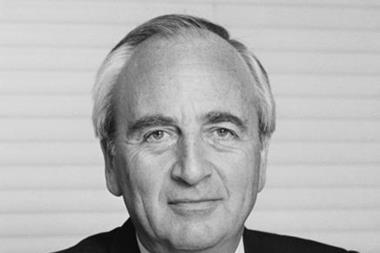Companies with overseas divisions are among the winners from Wednesday's announcement, but Lloyd's underwriters lose out
For the insurance community, this week’s Budget contained a bit more drama than for the population at large.
One of the key headlines in the announcement on Wednesday was the move on corporation tax, part of chancellor George Osborne’s wider drive to boost the competitiveness of the UK economy.
Insurance companies, like all major businesses, will benefit from the acceleration in the cuts to the headline rate of corporation tax.
But of more immediate interest to insurers were the Treasury’s moves on the taxation of UK-based companies’ foreign profits.
For those companies that organise their overseas activities as subsidiaries, the Budget offered a revamp of the so-called controlled foreign company (CFC) rules, which govern their operation.
New CFC rules will be introduced in next year’s Finance Bill with fresh consultation to be published in May, followed by draft legislation in the autumn. Overseas subsidiaries will be exempt from a large chunk of UK corporation tax, equivalent to a rate of just 5.75% by 2014. The Budget report promised “interim improvements to the current CFC rules” in this year’s Finance Bill 2011.
Branch reform
But for insurers, an even more important issue is the move to revamp the taxation of those multinationals which use a branch structure. This is due to the interplay with Solvency II which is due to come into force at the beginning of 2013. Under the upcoming EU directive, companies based on the more decentralised branch structure will have to hold greater capital on their balance sheets than those using subsidiaries.
With more capital on their balance sheets, such companies will have to pay a higher level of corporation tax, making this structure a less attractive option.
The Budget said that the Finance Bill would include measures to exempt foreign branches of UK companies from British rates of corporation tax.
For ABI director of financial regulation and taxation Peter Vipond, this move is particularly welcome.
He said: “ The revisions to the exemption for foreign branch profits will particularly help attract and retain insurers in the UK. This is important for UK insurers because the new EU-wide Solvency II regulations favour branch structures [over subsidiary structures] as they make more efficient use of capital.”
Waiting for clarity
However, while the likes of advertising giant WPP have signalled their intentions to redomicile in the UK following this week’s changes, insurers have been more cagy.
The Bermuda-based Lloyd’s insurers Catlin and Hiscox both declined to comment in response to inquiries from Insurance Times on the issue. Beazley, which is based in Dublin, was unavailable for comment.
KPMG financial services partner Susan Hill says: “I suspect the insurance industry might want to see a little bit more in the way of clarity. The CFC regime is also undergoing a process of reform, and companies might want to hold fire until they see exactly how the revised CFC rules will work.”
An additional push factor for companies operating in the Republic of Ireland is the pressure on the Dublin government from other EU member states to increase its corporation tax.
Meanwhile in the background, the European Commission is working on proposals to harmonise the EU’s corporation tax regime. Whitehall may be able to use its exemption from EU agreements on corporation tax in its favour in the longer term.
A plus for equalisation reserves
Another positive for general insurers, particularly those that write more volatile lines of business, is the government’s stance on claims equalisation reserves. These are used by insurers, particularly those dealing with unpredictable, catastrophic risks, to cushion against the effect of large losses in bad years, thus reducing earnings.
In the Budget it announced it was mindful to maintain the tax relief on these reserves if the industry can present a good case for maintaining them.
According to KPMG, UK insurers’ equalisation reserves stood at £2bn in 2008. Therefore, a lack of tax on these reserves could save insurers £500m a year on average under the new corporation tax rates.
Under Solvency II, equalisation reserves will no longer be recognised in companies' accounts or for regulatory purposes, but as the tax deduction is based on the regulatory calculation of the reserve levels, this potentially placed their tax deductibility under threat. However, assuming the industry presents a good case for keeping the reserves, Her Majesty’s Revenue & Customs (HMRC) has come up with some potential solutions.
“As a consequence of the introduction of Solvency II, HMRC is considering two options,” said Barry Case, senior manager in the financial services tax group at KPMG. “Option one is to either change the tax rules to allow continuation of relief for an equalisation reserve, or make a slight amendment to how the calculations are made – both essentially maintenance of the status quo. The second option is that the existing reserves are released and will be taxed but that tax will be spread over a period of six years.”
Lloyd's members' long wait
However, Lloyd’s underwriters face less welcome news as a result of the Budget.
The government announced it will consult the industry on the timing of the taxation of reinsurance premiums for Lloyd’s members.
Lloyd’s uses a three-year accounting system, which means underwriting years remain open and are not accounted for until 36 months after the business has been written to allow claims to develop.
However, when Lloyd’s firms buy reinsurance on their books of business, they are currently able to get a tax deduction on the premium they pay out to reinsurers in the year they do so, and do not have to wait until the underwriting year has closed.
Under the new proposals, HMRC would introduce new legislation that would bring the tax deduction for reinsurance expenditure in line with the three-year accounting. So not only will Lloyd’s firms have to wait longer for their tax break, thanks to the reduction in corporation tax, they will get less back. For example, a company writing business in 2012 would not get its tax break on reinsurance expense until 2015, and would be getting it at the new lower rate of 23%.
HMRC had already changed its guidance to reflect its intentions to align the tax deduction and the accounting back in 2009, but did not make any corresponding rule changes.
KPMG’s Hill says: “If the rate of UK corporation tax rate wasn’t changing, that point wouldn’t apply but because the rates are coming down, the deduction will be at a later point when the rates are reduced. Lloyd’s groups may be irritated but it is not a surprise because it has been in debate for some time. It has been quite clear where HMRC wanted to get to, it is just that without changing the law the industry view was that they couldn’t get there.”






































No comments yet